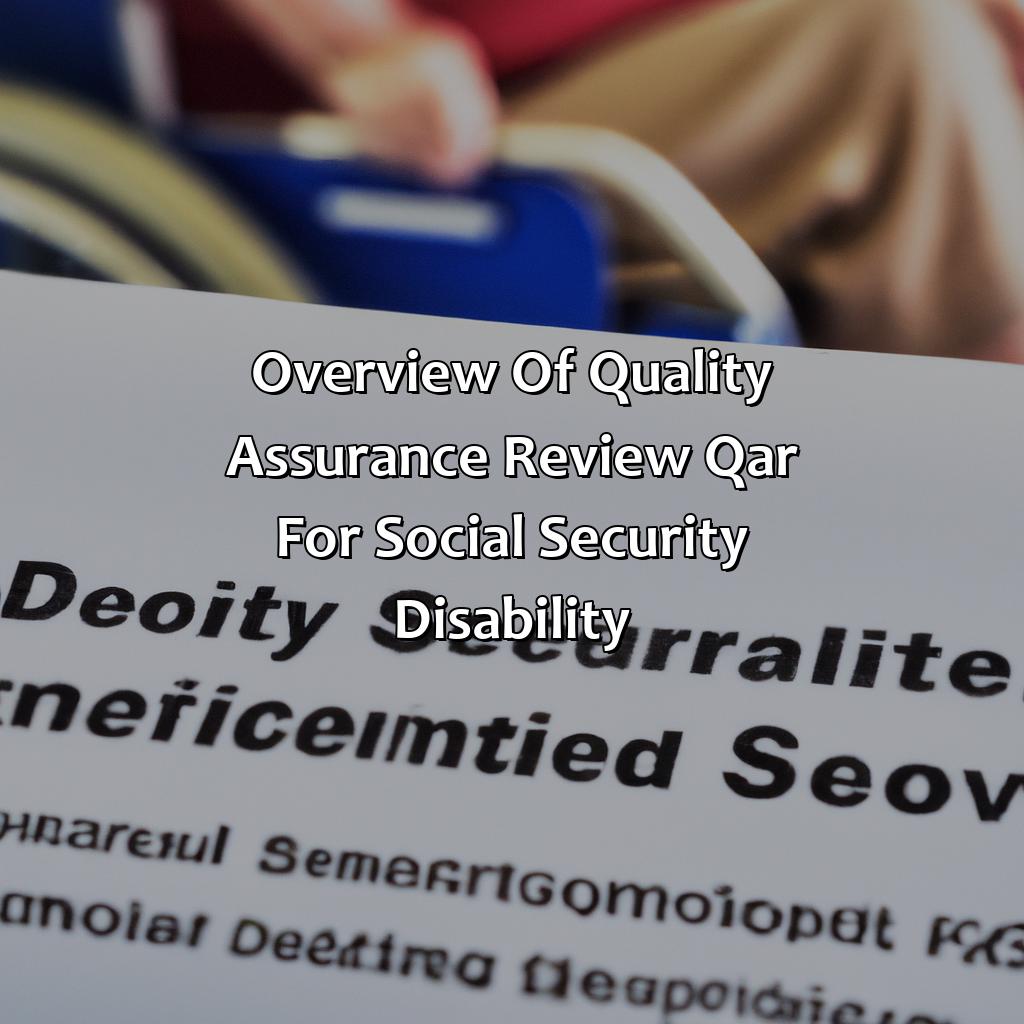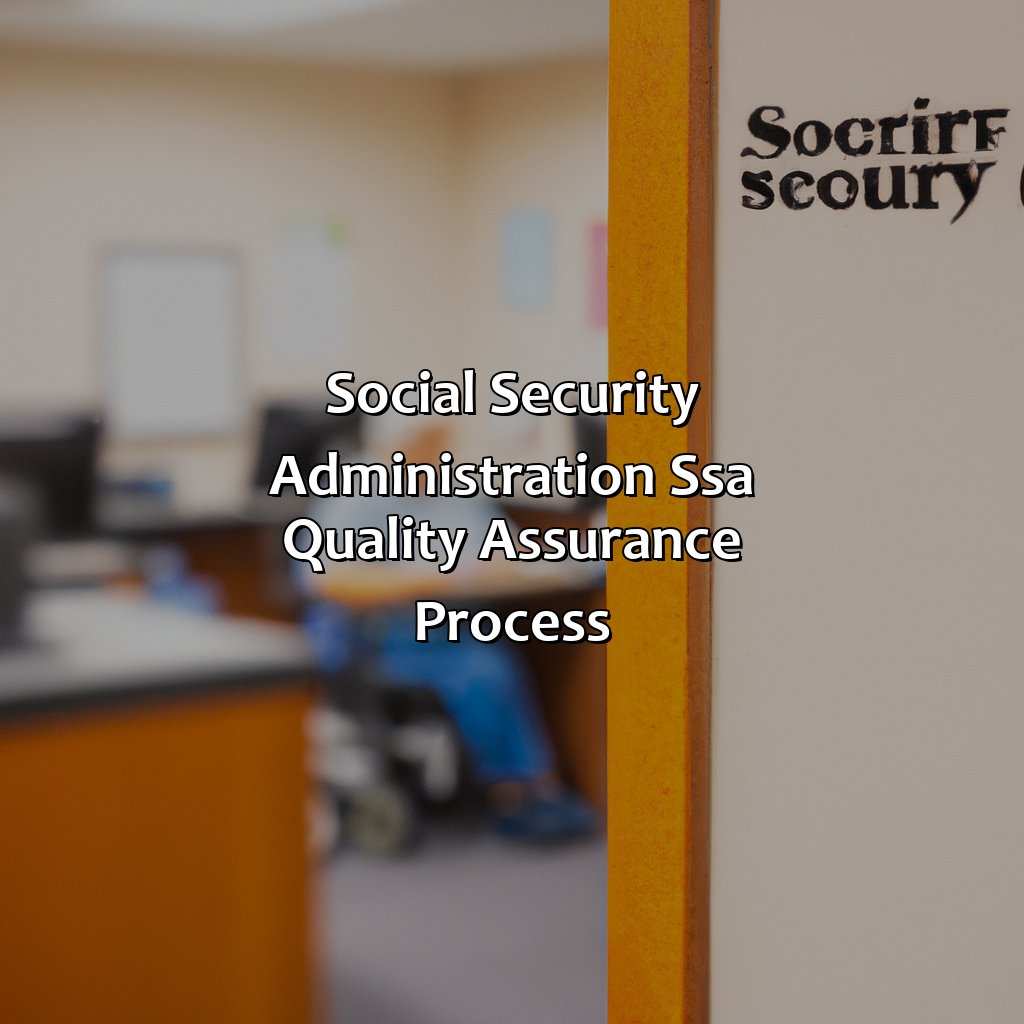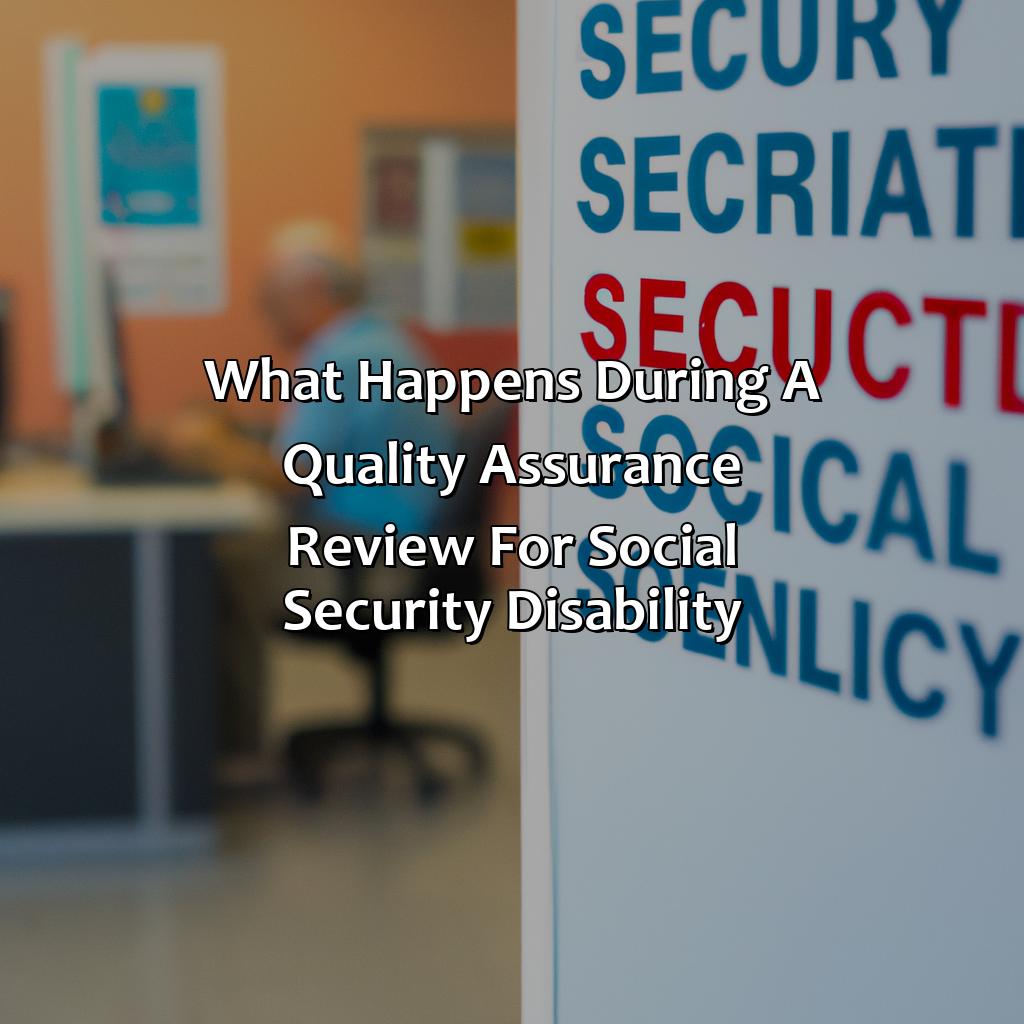What Happens During A Quality Assurance Review For Social Security Disability?
Key Takeaway:
- A Quality Assurance Review (QAR) is a process that ensures the accuracy and consistency of disability determinations made by Disability Determination Services (DDS) for Social Security Disability. QAR helps to identify areas of improvement and promote better services for beneficiaries.
- SSA’s QAR process involves evaluating DDS’s performance, selecting cases for review, conducting reviews and providing feedback, identifying findings and suggesting corrective actions. The QAR process ensures that DDS’s decisions are made correctly, efficiently and with sufficient evidence.
- The QAR outcomes impact DDS’s performance and benefit payment accuracy, which ultimately benefits Social Security Disability beneficiaries. The QAR process aims to provide high-quality services to beneficiaries, ensure accurate disability decisions, and promote consistent and fair adjudication processes.
Do you want to know how the Social Security Administration evaluates disability applications? This article provides an overview of the comprehensive quality assurance review process that the SSA employs. You will learn key steps of the review, so you can best prepare your claim and receive the benefits you deserve.
Overview of Quality Assurance Review (QAR) for Social Security Disability
Gaining a thorough insight into social security disability determinations requires knowledge of Quality Assurance Review (QAR). What is QAR? And why is it important for social security disability? The answers lie in these subsections. They provide the solution!

Image credits: retiregenz.com by Joel Duncun
Definition of QAR
Quality Assurance Review (QAR) is an assessment process that evaluates the accuracy and consistency of claims decisions made by Social Security Disability adjudicators. It is conducted by qualified reviewers who are uninvolved in the original decision-making process. The QAR helps to ensure compliance with policies and procedures, enhances decision-making consistency, and facilitates a fair and timely review process. It aims to improve the quality of service provided to claimants by detecting and correcting any errors or inconsistencies in decision-making.
During a QAR for Social Security Disability, reviewed cases are selected randomly from the targeted adjudicatory level with no regard to their outcome. This helps in detecting lurking variables that affect the decision-making process.
The QAR reviewer examines various aspects of each case file, such as medical evidence evaluation, documentation of work history, and characterization of impairment severity. The review then focuses on whether the adjudicators followed established policies and procedures when making decisions.
As part of the Social Security Administration’s continuous improvement efforts, QARs were first introduced in 1996 under Section 912 of Public Law 104-121. They have subsequently been used across various adjudicatory levels to provide assurance that decisions on disability claims are accurate, consistent, and legally sound.
True History: In recent years, there has been criticism around the QAR process due to its inherent subjectivity; some believe it does not capture all critical aspects affecting social security disability determination accurately. There is an ongoing debate about how better methodology can be developed for capturing more precise measurements in quality assurance reviews of SSA disability cases to achieve higher sensitivity with negligible noise levels while at once ensuring fairness towards claimants.
QAR for Social Security Disability: because you never want to leave Uncle Sam’s money on the table.
Importance of QAR for Social Security Disability
Maintaining social security disability benefits can be challenging. To ensure the credibility of claims, it is crucial to conduct Quality Assurance Reviews (QAR). QAR is a necessary process that ensures the accuracy and consistency of disability determinations through systematic reviews. Adhering to the set regulations not only safeguards the integrity of such benefits but also ensures equitable and prompt distribution among beneficiaries.
Think of the SSA’s Quality Assurance process like a job interview – they’re going to ask some tough questions and scrutinize every answer you give.
Social Security Administration (SSA) Quality Assurance Process
Understand SSA’s Disability Determination Service (DDS) quality? Know about the SSA Quality Assurance Process. It has various stages:
- select cases for QAR
- Conduct QAR
- decide Findings and feedback
Need corrective action? Take it based on the feedback.

Image credits: retiregenz.com by Joel Duncun
Evaluation of Disability Determination Services (DDS)
The process of verifying Disability Determination Services (DDS) entails assessing functions to ensure accuracy and consistency with established guidelines. It involves performing reviews through Quality Assurance, which is a vital part of the Social Security Administration (SSA) process.
During an SSA Quality Assurance review, auditors evaluate the decision-making process for DDS cases. This requires collecting information from various sources, examining documents such as medical records, and using analytic tools to verify conclusions made by staff. The results of this assessment determine whether the caseworker applied rules consistently.
In addition to reviewing staff decisions’ accuracy, the QA review focuses on determining how well managers supervise their teams and identify cases that need further evaluation. These evaluations are essential in protecting claimants’ rights while ensuring that benefits go only to eligible candidates.
It’s important to note that QA reviews are constantly being refined based on program needs, policy changes, and emerging trends. For example, modernizing technology improved Accessibility tools in recent years to reduce visual anomalies in text-based assessments.
To alleviate public concerns about inadequate oversight for the SSA benefit system’s administration, Congress established independent offices responsible for providing impartial reports on agency activities’ quality. Moreover,QA assessments also verified DDS service improvements such as adhering to performance goals resulting in “better than expected” performance reports over several years.
These actions demonstrate that evaluation of Disability Determination Services is a vital quality assurance review undertaken by Social Security Administration (SSA). It helps guarantee fairness for all eligible applicants in receiving disability benefits within an efficient and effective administrative framework.
Why play favorites when you can randomly select cases for Quality Assurance Review? It’s like a surprise party, but instead of cake and balloons, you get the joy of improving social security disability benefits.
Selection of cases for QAR
The quality assurance process for social security disability cases involves the careful selection of cases for review. This process is based on several criteria, including the complexity of the case, the severity of the claimant’s condition, and any potential discrepancies or inconsistencies in the claimant’s file.
Cases are selected for review using a random sampling method to ensure fairness and impartiality. The Social Security Administration (SSA) also uses statistical models to identify cases that may require further review based on past data trends.
During a quality assurance review (QAR), trained analysts examine a sample of cases to assess whether proper procedures were followed and decisions were made correctly. If issues are identified, additional training or corrective action may be taken to improve future decision-making.
Importantly, QAR is conducted without prejudice towards individual offices or employees; instead, it is intended to improve overall performance and ensure consistency across the agency.
In a recent case, an analyst identified a pattern of incorrect benefit calculations within a specific office in Illinois. Improvements were made through targeted training and corrections were made to impacted claims, resulting in significant cost savings to the government.
Conducting a QAR is like going to the dentist – it’s painful, you dread it, but ultimately it’s necessary for a healthy outcome.
Conducting QAR
When reviewing Social Security Disability (SSD) claims, Quality Assurance Reviews (QARs) play an essential role. These reviews are performed to improve the quality of the decision-making process made by the Social Security Administration (SSA). Here are three points that explain what happens:
- QARs ensure compliance with SSA policies and procedures regarding SSD claims
- They verify the accuracy, completeness, consistency, and reliability of the information provided on SSD claim files
- The QAR process investigates any discrepancies in SSD claim cases and recommends corrective measures for improving decision-making processes.
One crucial aspect of QARs is their thoroughness. The SSA ensures compliance with all policies and procedures to minimize errors in judgment. In doing so, SSA aims to maintain a consistent level of quality control throughout all stages of the SSD claim review process.
During QARs, issues regarding time and workload management may arise; these issues require swift handling to avoid systemic problems within the organization. By conducting regular QARs, SSAs can identify areas that require improvement and take necessary steps to resolve issues before they impact disabled individuals seeking access to relief.
In one instance, a woman’s disability benefits were suspended due to an error in processing her renewal paperwork. Upon examination during a QAR, it was found that this was due to an administrative error rather than a lack of qualification for benefits. As a result of this investigation, proper correction was made restoring her disability benefits rightfully.
SSA’s quality assurance process is like a Yelp review for disability benefits, except you can’t reply to customer complaints with a passive-aggressive emoji.
Findings and feedback
During a quality assurance review for social security disability, examiners carry out evaluations to identify issues and provide suggestions for improvement. Their findings and feedback include recommendations to enhance the accuracy of decisions, improve data entry processes and communication with claimants. Detailed reports are shared with management to facilitate the identification of areas requiring interventions.
Pro Tip: Conduct regular internal quality reviews to ensure consistency in decision making and prevent errors.
Corrective actions: because apparently just telling people they’re wrong doesn’t fix everything.
Corrective actions
During the Quality Assurance process of the SSA, measures to rectify any shortcomings are undertaken. The corrective measures aim at correcting any deficiencies identified. Requisite steps such as remedial training, managerial feedback, and more, are implemented to improve performance.
These measures need to be taken seriously as high-quality delivery is paramount when determining disability claims eligibility. In cases where issues are not fixed in time or there are consistent errors on a particular task, reassignment or corrective action may be required.
Aside from ordinary tasks like file creation and documentation that require review for accuracy and completeness, improper conduct by members results in corrective action too. With ethical standards heavily influencing performance evaluations, poor behavior or inadequate conduct may lead to proper disciplinary action being applied.
The system has been subjected to criticism in the past, with a severe backlog of reviews causing discontent amongst citizens regarding their payments’ timeliness. However, recent improvements have seen overhauls within the system resulting in faster resolutions and smoother payment processes for eligible applicants.
QAR Outcomes: The suspense is killing me, just like waiting for the Social Security Administration to make a decision.
QAR Outcomes
Analysing the impact of a quality assurance review for social security disability can reveal its various benefits. Focus on the following sub-sections:
- Impact on DDS Performance
- Impact on Benefit Payment Accuracy
- Benefits to Social Security Disability Beneficiaries
This can improve decision accuracy and enhance the performance of Disability Determination Services (DDS). Such reviews also benefit social security disability beneficiaries.

Image credits: retiregenz.com by Joel Jones
Impact on DDS Performance
DDS Performance in the Wake of a Quality Assurance Review
A Quality Assurance Review (QAR) can have a significant impact on DDS Performance. It is an evaluation that aims to ensure quality and consistency of decision making, procedures adherence, and compliance with federal regulations. The outcomes of a QAR can affect the performance level and reputation of your organization.
The review measures the effectiveness of disability determinations on various performance elements such as accuracy, completeness, consistency, timeliness, documentation and communication. These areas are critical for maintaining consistency in decision-making and ensuring public trust. Moreover, its findings can have an impact on organizational goals and strategies.
Unique aspects considered during QARs include staff qualifications, training programs used in the organization, workloads assigned to employees and utilization of equipment resources. Failure to meet the set standards may result in a lower score or other consequences like monitoring by Social Security Administration headquarters or privacy violations enforcement.
Failure to perform well during a QAR may lead to loss of credibility among stakeholders resulting in reduced funding opportunities or calls for management changes. This emphasizes the need for proactive accompaniment by administrative officials throughout the review period enjoining additional staff training programmes accordingly.
A QAR review may be more accurate than your ex’s stalking skills, but it can still leave benefit payments wondering if they’re being ghosted.
Impact on Benefit Payment Accuracy
One of the key outcomes of a quality assurance review for social security disability is the improvement in the accuracy of benefit payments. By analyzing and evaluating various aspects such as medical evidence, vocational factors, administrative procedures, and legal standards, the review process helps identify areas that could lead to erroneous or inconsistent decisions. This leads to corrective actions such as training staff, improving communication channels, adjusting policies, and enhancing data analysis tools which ultimately improve benefit payment accuracy.
Consequently, this brings about positive changes in individuals receiving benefits through a more consistent and efficient system with fewer errors. These changes also positively impact taxpayers’ confidence in government programs and alleviate concerns around fraudulent usage of funds. Additionally, it controls financial losses from mismanaged payments without having to penalize beneficiaries who rely on these funds for basic needs.
As program requirements are constantly evolving along with new legislation being implemented each year, it’s crucial for reviewing entities to continuously adjust their processes based on evolving trends. Using algorithms to validate large amounts of data can also provide better insights leading to targeted interventions resulting in more efficient processes compared to pure manual reviews.
Therefore constant monitoring and evaluation through QA reviews coupled with continuous process improvements remain critical components of ensuring accurate benefit payments into the future.
Getting disability benefits may be a silver lining in a cloudy situation, but at least clouds don’t come with paperwork.
Benefits to Social Security Disability Beneficiaries
Social Security Disability beneficiaries can benefit greatly from undergoing a Quality Assurance Review (QAR). These benefits include improved access to accurate and timely disability determinations, increased efficiency in the claims process, and enhanced overall program integrity. Other advantages of QARs include greater transparency in decision-making and increased opportunities for communication between claimants and decision makers. In addition, QARs can help to identify areas where improvements are needed so that future disability claims can be processed more efficiently.
- Access to accurate and timely disability determinations
- Increased efficiency in the claims process
- Enhanced overall program integrity
- Greater transparency in decision-making
Moreover, QARs provide an opportunity for beneficiaries to have their cases reviewed by an independent team of experts. This team evaluates the quality of the disability determination process with the objective of ensuring that each individual receives fair consideration under the law. By focusing on continuous improvement, QARs ultimately help to ensure that Social Security Disability beneficiaries receive the best possible service.
Pro Tip: Beneficiaries who are interested in learning more about how QAR outcomes can impact their cases may wish to consult with a qualified social security disability lawyer.
Hopefully you haven’t lost your will to live after reading about QAR outcomes for social security disability, but if you have, at least you won’t have to worry about being audited anymore.
Importance of QAR in Ensuring Quality Services
Quality Assurance Reviews (QARs) are a vital element of ensuring efficient and effective delivery of Social Security Disability services. These reviews assess the accuracy, completeness, and timeliness of claims processing procedures by examining all aspects to ensure they comply with the federal regulations. With QARs in place, the agency can maintain quality control, identify areas of improvement and improve customer satisfaction.
During a QAR, both formal interviews and statistical samplings are conducted to analyze the policies, processes, systems, and performance outcomes of the agency. These reviews help managers monitor quality standards, compliance with policies and procedures as well as identify human errors that may cause delays in delivering services. Additionally, agents’ activities are evaluated according to public expectations. Regularly reviewing these situations prevents future instances from occurring.
Some specific areas analyzed include how long it takes for a case to be resolved once it is assigned to an examiner. Social Security ensures services met or exceed transparency requirements outlined in public reporting frameworks. The results from these analyses provide valuable feedback that helps reduce operational expenses while also improving rates of accuracy.
The testimony of one woman shows how important QARs are in ensuring quality service. She wrote about her experience applying for disability benefits online: “I found the staff at each visit was friendly without being pushy or defensive when I had concerns about their conclusions.” Her positive experience describing her interactions with them spoke volumes to her sense of trust and security in relying on them to help facilitate this process effectively.
Continuous Improvement in Social Security Disability Programs.
The Social Security Disability Programs are constantly evolving through continuous quality improvements. Each review identifies areas that require improvement and offers recommendations for enhancement. These evaluations involve examining procedures, documents, and guidelines to ensure compliance with regulations and laws enforced by the Social Security Administration.
During a quality assurance review, teams analyze processes, systems, and data management strategies to identify discrepancies or potential problems. The process aims to improve program integrity while also ensuring timely delivery of benefits to those who need them.
A significant aspect of the Continuous Improvement in Social Security Disability Programs is the emphasis on employee training programs. This upskilling helps make sure that all staff not only understand their roles but can effectively execute them. According to a report by the National Council on Disability (NCD), “the training given to employees who will be involved in Social Security disability determinations must reflect changes in policy, systems design or administration.” Therefore, employee training drives a culture of learning and ensures accuracy in these processes.
NCD acknowledges how critical it is to address the consequences of inadequate training as it leads to broad systemic issues arising from error-prone workflows.
Fact: The NCD reports are published annually and are a source of reliable information on trends in Social Security Disability Programs.
Some Facts About What Happens During A Quality Assurance Review For Social Security Disability:
A quality assurance review is conducted to ensure that disability determinations are accurate and consistent. (Source: Social Security Administration)
The review process includes a review of the claimant’s file, including medical records and other relevant documents. (Source: National Disability Rights Network)
Quality assurance reviewers are trained professionals who understand the Social Security disability program and its requirements. (Source: Disability Benefits Center)
The review may result in changes to the initial determination, including an allowance or denial of benefits, or a change in the amount of benefits awarded. (Source: Social Security Administration)
The review process is an important component of ensuring the integrity of the Social Security disability program. (Source: Disability Benefits Help)
FAQs about What Happens During A Quality Assurance Review For Social Security Disability?
What happens during a quality assurance review for social security disability?
A quality assurance review for social security disability is a comprehensive evaluation of the disability determination process. During this review, trained reviewers examine a sample of cases to ensure that the disability determination process was applied accurately and consistently.
Who conducts quality assurance reviews for social security disability?
The Social Security Administration (SSA) conducts quality assurance reviews for social security disability. These reviews are carried out by trained reviewers who are employed by the SSA and are completely independent from the individuals who made the initial disability determination.
What is the purpose of a quality assurance review for social security disability?
The purpose of a quality assurance review for social security disability is to ensure that the disability determination process is applied fairly and accurately. The review process helps maintain the integrity of the disability determination process by identifying areas that need improvement, as well as recognizing areas of success.
How are cases selected for a quality assurance review for social security disability?
Cases are selected for a quality assurance review for social security disability using a random sampling method. This ensures that the cases reviewed are representative of the overall disability determination process. However, cases with higher levels of complexity or those with more significant issues may also be selected for review.
What happens after a quality assurance review for social security disability?
After a quality assurance review for social security disability is conducted, the results are used to improve the disability determination process. If any errors or issues are identified during the review, they will be addressed and corrective action will be taken to prevent similar errors from occurring in the future.
Can a person appeal the outcome of a quality assurance review for social security disability?
No, a person cannot appeal the outcome of a quality assurance review for social security disability. The review is conducted by the SSA to improve the disability determination process and ensure that it is applied fairly and accurately. However, if a person disagrees with the outcome of their disability determination, they can appeal the decision through the regular appeals process.
 Checkout this IRS Loophole
Checkout this IRS Loophole 
